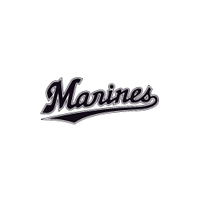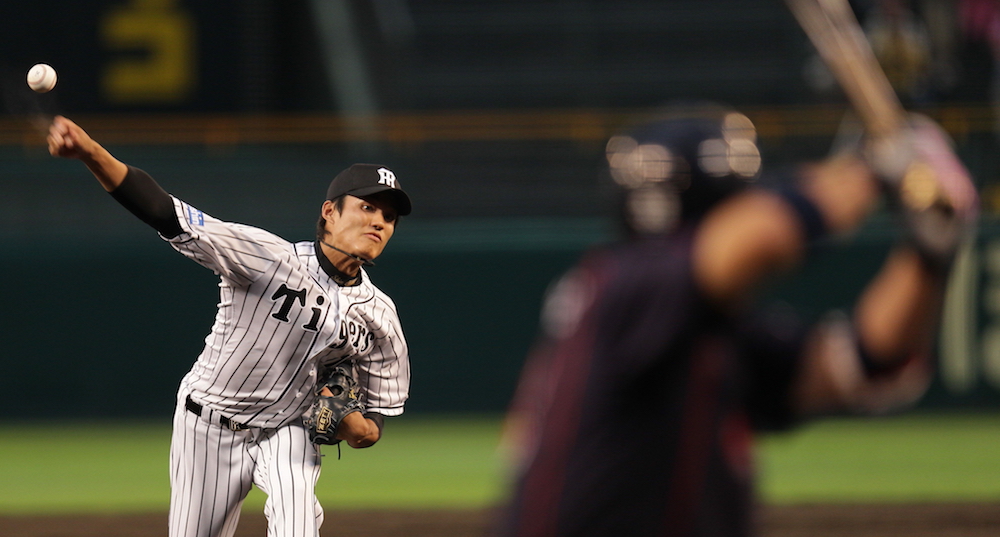Feature Photo: Shintaro Fujinami, RHP, Hanshin Tigers

In the third edition of our NPB Update newsletter, contributors Mike Shubin and Dave DeFreitas break down a few more names from the Nippon Professional Baseball League that you have likely never heard before, but that could impact MLB free agent classes in future years.
DeFreitas also goes over Shohei Ohtani’s latest hot streak – at the plate and on the mound – and how he is making it harder and harder to discount the idea of a player having a two-way impact at the major league level.
Nippon Professional Baseball League Players to Watch
 Sho Nakata, 1B/DH, Hokkaido Nippon-Ham Fighters
Sho Nakata, 1B/DH, Hokkaido Nippon-Ham Fighters
Ht/Wt: 6’0”/209 B/T: R/R Age: 27
Nakata has been on MLB teams’ radars since 2007, when he was the top power prospect in NPB the draft by a large margin; the Mets, Mariners and Twins all were said to have significant interest in trying to sign him before the draft, but he ultimately went to the Nippon-Ham Fighters with their 1st pick. Nakata is a big, thick kid with tremendous lower-half strength. He has a good deal of length to his swing and an uphill plane to go with a track record of significant swing and miss. But the plus raw power is very real, and he can drive the ball out to any part of the ballpark. He doesn’t have to square it up to hit it out, and he does not miss too many mistakes out over the plate, but he has consistently struggled with breaking stuff on the outer third of the plate and can be pitched to.
With power hitters being at such a premium in Japan, Nakata was rushed to the big leagues there, making his debut as a 20 year old in 2009. He did not have much of an approach, and struck out a whopping 31% of the time going up and down between the Fighters and the minor leagues during his first two seasons. He made a concerted effort to work on the swing and miss, and pared the K rate down to 25% in his first full season at the top level, and has since seen steady improvement before posting rates between 17% and 19% from 2012-14. He regressed a bit to 22% in 2015, and so far this year is sitting at 21%.
2015 was his best year as far as offensive production goes, with 30 HRs (career high), 26 doubles and an .817 OPS. He has also proven to be very durable, tallying 600+ PAs three times in his first five full seasons, and never having fewer than 459 PAs, which happened in 2013, and was due to a broken left pinky finger.
Nakata has never really had a position on defense. He was a catcher in high school, but was quickly moved to third base as a pro and then to the outfield when that didn’t work out because of poor athleticism and generally slow feet. He would have been an ideal fit for first base if not for his plus arm. As a rookie I had it at a 60 grade, and it played well at a corner outfield spot. However, he does not run well, and he would consistently get poor reads. Since the beginning of 2015 he has been almost exclusively a first baseman, and now seems destined to remain there.
Recently there have been some rumors that he may be posted after the 2017 season (he’s now set to hit international free agency after the 2019 season). However, I’m not sure that it would be worthwhile for the Fighters to do so; Nakata is a fan favorite in Sapporo, and his power potential holds a good bit more value in the NPB than it does in MLB. Byung-Ho Park (DH, Twins) is a semi-close comparison, and he only drew $12.85 million after a season in which he hit .343 and 53 home runs’s. Nakata is not a great athlete, and is below average in the outfield and at first base. Overall, I would grade Nakata as a step below Park with similar defensive limitations. So in all likelihood, the value offered by a major league club may not be enough for the Fighters to give up their best power threat. – Dave DeFreitas
 Shohei Ohtani, RHP, Hokkaido Nippon-Ham Fighters
Shohei Ohtani, RHP, Hokkaido Nippon-Ham Fighters
Ht/Wt: 6’4”/205 B/T: L/R Age: 22
Ohtani has not only been raking at the plate in the month of June, but in his start on June 11th vs. the Hanshin Tigers, he threw a fastball clocked at 163 kph, or 101 mph (Video by NPB via Facebook) while facing Tsuyoshi Nishioka that broke Marc Kroon’s record of 162 kph (100 mph) for the highest velocity ever recorded in an NPB game. This was at the Tokyo Dome, and their stadium gun is inconsistent at best, so this should be taken with a grain of salt. However, Ohtani has topped 100mph on scouts’ guns a number of times over the years, so my guess is that he has done this a couple times before. Velocity aside, he has been much better in recent starts, and he continues to rake at the plate. He now sits at 91Ks through 78.1 IP and he has lowered his ERA to 2.97.
He looks to have a rhythm that he was not showing earlier in the year, sitting at 95-to-99 mph with the fastball, consistently locating his splitter in the mid-to-upper 80’s, and his big curveball is in the upper 70’s. That’s about a 15-to-20 mph difference off the fastball, with two secondary pitches that he has arm speed with, not simply flipping it up there every so often. Add in the fact that he is dialing up 100-to-101 mph when he needs it and it is safe to say he’s feeling pretty good now.
On the offensive side it is more of the same. Two weeks ago he became the first pitcher in the history of the DH rule to start the game and hit for himself. Ohtani has, in effect, forced Nippon Ham to plug him into the lineup as often as possible. He is hitting .343 with a 1.116 OPS, with a 1.6:1 K:BB ratio through 121 PAs (he needs 68 more PA’s to qualify for the NPB batting title (Katsuya Kakunaka currently leads qualified batters with a .354 BA). He is swinging and missing some, but is inflicting some serious damage when he does make contact. Needless to say, the league is starting to get the picture, and soon enough will stop pitching to him altogether, but the 16 walks he has goes to show that the plate discipline is improving, and it won’t be so easy as to just let him get himself out.
All in all, it’s a long season, and those that think this kid can produce offensively AND pitch atop a big league rotation remain in the minority. Personally, I see a little bit of an uphill bat path, and with such long levers, he has to open up early to get to even average velocity inside. He has above-average power the other way, and to the middle of the field, but he has some length to the swing and the better velocity in could give him fits. That said, this kid is making believers out of non-believers every time out, and if we are still seeing these types of numbers come October, a permanent two-way player will be a hard idea not to take seriously. – Dave DeFreitas
 Shintaro Fujinami, RHP, Hanshin Tigers
Shintaro Fujinami, RHP, Hanshin Tigers
Ht/Wt: 6’5”/189 B/T: R/R Age: 22
Fujinami was the #1b to Ohtani’s #1a in the 2012 NPB draft. Sporting a similarly lanky, athletic build and power arm, Fujinami was actually seen as more advanced than Ohtani at the time. He had better fastball command and far superior secondary stuff. While it is safe to say that Ohtani has passed him with regard to strength of stuff, Fujinami has enjoyed considerable success thus far in his young career.
In 2015 he posted a career-high 223 strikeouts in 199 innings, and a career best 7.3 H/9, and has never dropped below 8.2 SO/9 in his short, three-plus year professional career. Fujinami’s plus fastball does tend to be fairly flat with run and occasional late tail. His 6’5″ frame, however, provides him with ample angle and allows him to really drive it down in the zone. He has the ability to get very good extension when he’s right, and can be very effective pounding the pitch in on left-handed hitters. However, consistency of fastball command has been an issue. He tends to open the front side very early and it causes his arm to drag, and that results in a good number of pitches either leaking back over the plate or being lost up and away. His slider has the makings of a plus pitch, and I think it eventually will be – but similar command issues their limit the present effectiveness.
So far in 2016, his walks have been about the same as last year, but his hits allowed have shot up, and his strikeouts are down (to 8.1 H/9 from 7.3 H/9 and to 8.1 SO/9 from 10.0 SO/9 respectively). He has always worked with deep counts and has leaned on his stuff to overpower NPB hitters and battle back from the bad counts.
In two looks this year, he has not been as lucky and is seeing more mistakes over the plate get hit. Also, the disappearance of the changeup/forkball that I have seen in his first couple of seasons makes it tougher for him to keep hitters off of the fastball and hard slider. Fujinami is still a very good athlete, and I believe he will find some consistency as he matures; the open front side, and the hook/wrap in the arm action are of mild concern, but he should be able to repeat well enough to get to fringe-average command. He was not able to find much feel for anything in his last start on the road vs. the Chiba Lotte Marines, and exited early after taking a line drive off his pitching hand (x-rays were negative and he should make his next start). Fujinami is still five years away from international free agency, but look for posting talk to pick up on him next year, with a possible post after the 2018 season a possibility. Check out my full report on Fujinami here. – Dave DeFreitas
 Naoki Miyanishi, LHP, Hokkaido Nippon-Ham Fighters
Naoki Miyanishi, LHP, Hokkaido Nippon-Ham Fighters
Ht/Wt: 5’11”/165 B/T: L/L Age: 31
The Fighters selected Miyanishi in the third round of the 2007 NPB draft, and he made his NPB debut the following year. Although the sidewinding lefty struggled a bit in his first season out of the Fighters’ bullpen (4.76 ERA and only 25 Ks in 45.1 IP), he has hasn’t posted an ERA above 2.89 since then, or appeared in less than 50 games in a season. With his 50th appearance in 2015, he became only the third player in NPB history to appear in 50 or more games in eight straight seasons.
Miyanishi is off to a great start in 2016 with a 1.32 ERA, 1.02 WHIP, and 13 holds in 20 appearances (13.2 IP). His sidearm delivery is very similar to that of Javier Lopez (LHP, Giants) and Tommy Layne (LHP, Red Sox), and he features a fastball that tops out at 87-to-88 mph that he pairs with a sweeping slider and a curveball.
Having already qualified for domestic free agency once in Japan, Miyanishi will have the option of declaring as an international free agent at the end of the 2016 season. We can only speculate about his desire to play overseas, but there is always a demand for left-handed relief pitching, and Miyanishi would come at not too great a cost for any MLB team looking to sign him. -Mike Shubin
 Yoshihiro Itoi, RF, ORIX Buffalos
Yoshihiro Itoi, RF, ORIX Buffalos
Ht/Wt: 6’2”/194 B/T: L/R Age: 34
Itoi was drafted as a pitcher in 2003 by the Hokkaido Nippon-Ham Fighters through a now defunct system that allowed players with experience beyond high school to declare their desire to play for a certain team, whereupon that team could then select that player without having to use an actual draft pick. For the first two years of his pro career, Itoi appeared in 36 minor league games and pitched to a 4.86 ERA. The decision to convert Itoi to an outfielder was made in 2006 by Shigeru Takada, the general manager of the Fighters at the time, who cited Itoi’s speed and batting sense as indicators that he would make a better position player than pitcher. 10 years later, we can definitively say Takada made the right call.
Itoi made his NPB debut during a brief stretch in September of 2007, but it wasn’t until the 2009 season that he became a full-time player. In his first full season in the Fighters’ outfield, he had an OPS of .901, with 40 doubles, 15 home runs, and 24 stolen bases. Not bad for a former pitcher. He would follow that up with more of the same for the Fighters over the next three years, averaging about 12 home runs and 26 stolen bases from 2010-12. Following the end of the 2012 season, Itoi expressed a desire to be posted so he could pursue a Major League Baseball career. Instead, Nippon Ham traded him to the Orix Buffaloes. The trade had little effect on his ability to produce, as his first year for the Buffaloes saw him set a career high in home runs and stolen bases with 17 and 33, respectively, while maintaining a .300 average and playing nearly flawless defense (1 error in 141 games). Like many Asian hitters, Itoi uses a leg kick for timing and balance, but he does an excellent job at staying back on pitches and making contact, and his BB:K ratio in 2015 was an exceptional 72:78.
Now 34 (he’ll turn 35 in July), while Itoi may be on the back-end of his career, he could certainly serve as an asset for a major league team. The power and speed combo is still there, and through only 55 games in 2016, Itoi already has eight home runs and 17 stolen bases (with only one CS). He has been a member of Japan’s World Baseball Classic team in 2013 and the National Team for the MLB All-Star series last year, so he has had some experience playing against MLB players. Orix is unlikely to post Itoi, but with international free agency only about a year or so away, Itoi could be looking at finishing his career in the U.S. major leagues. – Mike Shubin
 Katsuya Kakunaka, LF, Chiba Lotte Marines
Katsuya Kakunaka, LF, Chiba Lotte Marines
Ht/Wt: 5’11”/176 B/T: L/R Age: 29
After graduating from high school in Ishikawa Prefecture, Kakunaka played a year of independent league baseball before being selected by Chiba Lotte in the final round (7th) of the 2006 draft for college and “adult” players (prior to 2008, NPB held one draft for high school players and another for players with experience beyond high school). He would spend his first four years as a pro primarily in the minor leagues. Kakunaka eventually got into 51 games for the Marines in 2011, but it wasn’t until 2012 that became a regular starter for the team.
From 2012 to 2015, Kakunaka posted averages of .312, .288, .277, and .293, never striking out more than 68 times in a season, and he consistently had an OBP above .360. He doesn’t excel in terms of power or speed – his career highs in home runs and steals are eight and 10, respectively – but his short, quick swing, and his ability to make consistent contact have made him a very tough out in the Marines’ lineup. Almost halfway through the 2016 season, Kakunaka is arguably putting together the best season of his career. His .354 BA through 57 games (the NPB regular season is only 144 games) leads the Pacific League and his .946 OPS is well above his previous career high of .787 set in 2014. He has only two home runs on the season, but his .505 slugging percentage is supported by 17 doubles and four triples in 206 ABs, numbers that already almost match the 20 and five he put up in 427 ABs in 2015.
Kakunaka is in his 10th year of pro baseball, but his accumulated NPB service time is closer to 5.5 years. With free agency still at least a couple of years away, it would be up to Kakunaka to express a strong interest in playing for an MLB team, and Chiba Lotte to subsequently make him available via posting. Kakunaku has already gained some international exposure as a member of Japan’s 2013 World Baseball Classic team, and although he is not currently on the roster for the Japan National Baseball team, if he continues to put up league-leading numbers, it will be hard for Japan to leave him off the roster for their 2017 WBC team. The high contact rates combined with his opposite-field approach tells me that his NPB success may translate, and give him value similar to So Taguchi (OF, STL, PHI, CHI from 2002-09) to an National League club. – Mike Shubin


